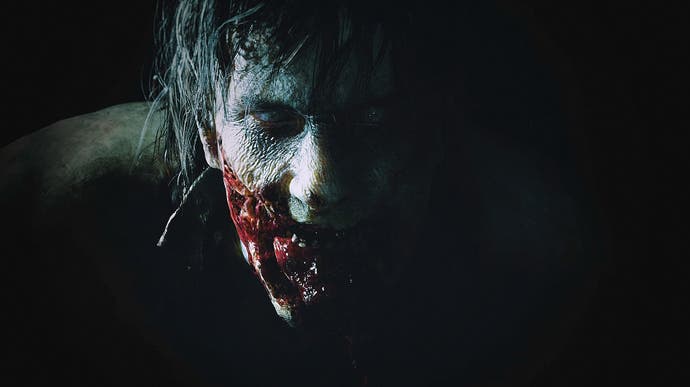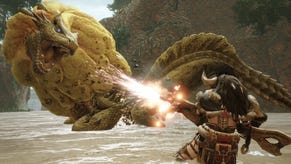How Resident Evil 2 exposes the horror of our bodies
Undressing the zombie.
"The idea that you carry the seeds of your own destruction around with you, always, and that they can erupt at any time, is... scary. Because there is no defense against it; there is no escape from it" - David Cronenberg.
THIS FEATURE AND THE IMAGES IN IT ARE NOT SAFE FOR WORK. PROCEED WITH CAUTION.
How many swipes or bites can your avatar sustain before its body is devoured and you fade to a death screen? Resident Evil has always involved physical maintenance: locked doors and blocked passages are overcome by shifting keys from room to inventory to item-box, and back again. But it's also a game of bodily preservation, as well as the destruction this necessitates. Why waste time with a handgun plinking away at a zombie's noggin when you can simply slip by? It can even be advantageous to take a hit. An attack might drop your obscure electrocardiography signal from "fine" to "danger", but there's always time to hit the menu button in panic and recover your health with a delicious herb.
Alongside your exposed player-character comes Resident Evil 2's assortment of monsters. The Raccoon Police Department's cramped corridors are clogged with all kinds of fleshy architecture and meaty obstacles. It's hard not to be reminded of death in the midst all of the game's face-munching and imploding craniums. Bodies are shown to be fragile and easily disfigured. And just as inevitable as death is the movement towards it in the form of deterioration. Monstrous bodies decompose and fall apart, mutate and transform, and all the while a viral infection invisibly annihilates.
Body horror is all about the fear and anxiety we have in regards to our failing bodies. We're aware of this persistent decay, but it usually happens slowly enough for us to dismiss or forget the fact. Occasionally bodily failures will appear suddenly, their horror bursting forth from the repressed and shadowy cavities of the mind.
Speaking of cavities, you may be aware of one of the most common recurring nightmares - losing your teeth. Dream analysis is a notoriously inexact science, so there are a number of interpretations, but the one that closely relates to body horror has to do with the fear of catastrophic breakdowns, as well as the lack of freedom that comes naturally from possessing a body.
One of the strangest anecdotes in medical science is the mystery of the exploding teeth. Documented in an American dental journal are several cases of the worst toothache imaginable. After several days of excruciating pain, "a sharp crack, like a pistol shot" would finally burst the tooth into fragments. In a second patient, the concussive impact was so great it almost knocked them over. The explanation for this nightmare? Like Umbrella Corporation's meddling scientists, it's possible that the exploding teeth were caused by early dental fillings. Made from metals like lead, tin and silver, the mix of alloys could have led to a build-up of hydrogen within the cavity, causing "spontaneous electrolysis" like a miniature battery.
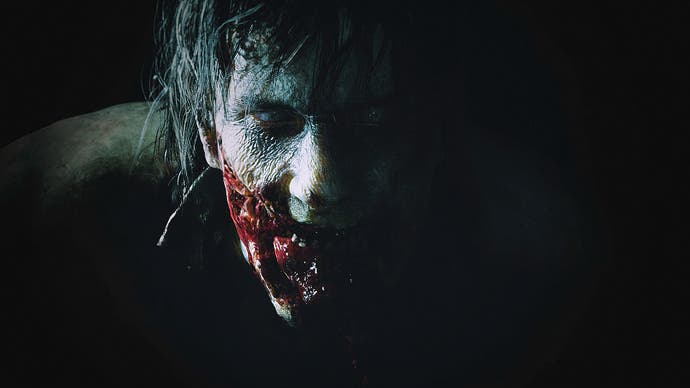
I'm reminded of another dental nightmare, this time fictional. In David Cronenberg's film The Fly, a young Jeff Goldblum is going through a horrific transformation. In one scene - face already a porous mush - his teeth seem to simply melt out of his mouth. In many respects, Cronenberg is the master of body horror. He was infecting bodies and exploding heads long before gory video games came along. The nasty, biological horror explored by Cronenberg has much to do with his own personal experiences. Early in his career, Cronenberg's father developed a rare and fatal disease, which while leaving his mind intact, slowly ate away at his physical body. Watching his dad die in this way was horrific. It's easy to understand why so many of his films explore the kind of themes they do, what he once described as the essential elements of body horror: “disintegration, aging, death and separation.”
Like Goldblum in The Fly, several of Resident Evil 2's characters monstrously metamorphosise. William Birkin is an antagonist whose body undergoes a series of grisly transformations as you progress through the game. When you first meet him he is recognisably human, save for one of his arms which has been overtaken by an enormous, bulbous growth. The limb - slick with blood and viscera - writhes about autonomously, slowly eating away at the remainder of William.
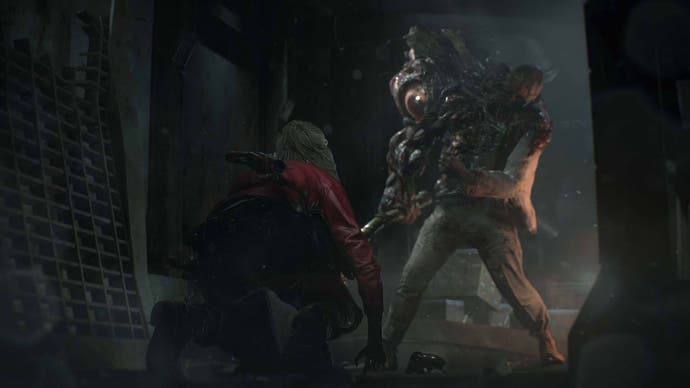
The most grotesque thing about William Birkin's body is the sudden appearance of a great bloodshot eye. The word grotesque comes from the discovery of ancient wall paintings found in a series of caves - or grottos. These walls belonged to the buried palace rooms of the Roman emperor Nero. The paintings depicted all kinds of mutated hybridity - strange growths, limbs and organic elements ripped from fauna and flora alike. The strange, distorted assemblages have been influential in art for centuries, and continue to be a potent source of disgust. Resident Evil 2's Plant 43 creatures, with their vines and flowering pustules, are in keeping with the compound fantasies of the grotesque. In a similar fashion, new elements are added to the body of William Birkin as the parasite takes hold. William's head dissolves away, while new limbs, eyes and even teeth emerge and amalgamate.

While William might be the most explicit example of bodily disintegration, the zombies highlight a slow, shambling death march. These are Resident Evil 2's most essential bodies. Slowly infected by the T-virus, characters like Marvin Branagh go from weary to complete capitulation the closer they get to their expiry date. When they do finally turn, their bodies crumble, and worst of all, shuffle on without them. It's this second element - of our freedom being stripped away - that gets to the heart of zombification. If we consider that the zombie myth originated with Haitian slavery, we might also begin to understand these creatures as an expression of bio-political anxieties. Bio-politics is the ordering and controlling of bodies, of having power over life. The viruses of Resident Evil - a concoction of pharmaceutical and military-industrial interests - have everything to do with the governing of populations and of regulating, subjugating and weaponing our bodies. A zombie's fate is the ultimate tragedy: death finally arrives, but bondage continues eternally.
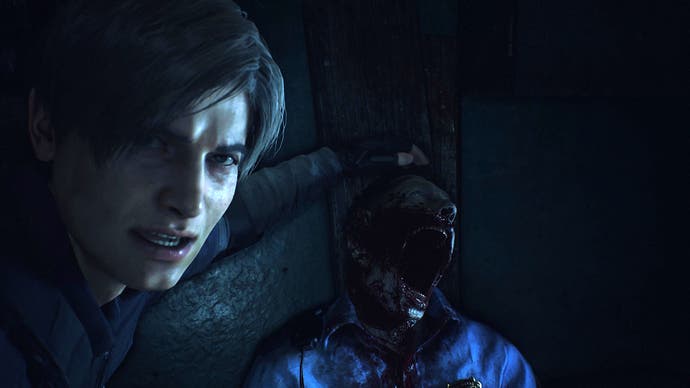
While we're afraid of our bodies being wrestled from our control, there's also the general discomfort from simply existing in one. We often fear outside agencies worming their way in, but there's an abundance of organisms like bacteria already living inside of us. We tend to suppress this idea, just as we do many of our more vulgar impulses and bodily functions. The French philosopher George Bataille grouped many of these under the concept of "base materialism". Bataille believed that traditional materialism was no better than forms of idealism. For him, bodies were not perfect, sacrosanct vessels, but a messy, multifarious substance.
Bataille's disruptive materialism accounted for the parasites within, as well as all our reproductive and excremental processes. While Resident Evil 2 is fairly conservative in regards to sex (although you're welcome to try and count the phallic symbols), the game's sewer level is particularly interesting in bringing muck and filth into the light. Sewers are by their nature repressive spaces. These infrastructural systems whisk human waste away, attempting to cleanse the unwanted with rivers of H2O. It's in the sewers that you meet one of Resident Evil's most horrific forms: the G mutant. These congealed masses are like living fatbergs. Clots of flesh, guts and, presumably, nappies, wet-wipes and condoms - they're an amalgamation of everything we attempt to flush away and keep out of mind.

So why is zombie fiction so bloody disgusting? To return to the original point - I think it has a lot to do with physicality. Unlike a Cronenberg film that can make heavy use of practical effects, games like Resident Evil 2 have to work digitally. Despite this limitation, there's a real effort made to imbue body and weight to its virtual world. Limbs deform, bits of bodies fall off but continue to squirm, and you wrestle, stab and shove grenades down zombie maws. As you limp through Resident Evil 2's many corridors and slip down its sewer banks, the game shows you how vulnerable bodies really are. Infected, mutated, torn asunder, there's no escaping death, or the decline of the bodies it ultimately claims.
